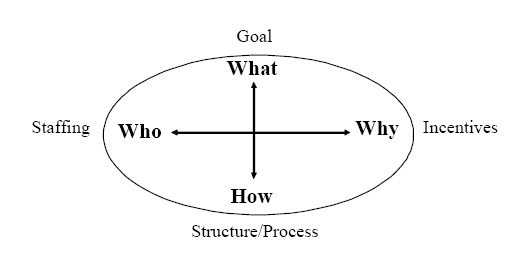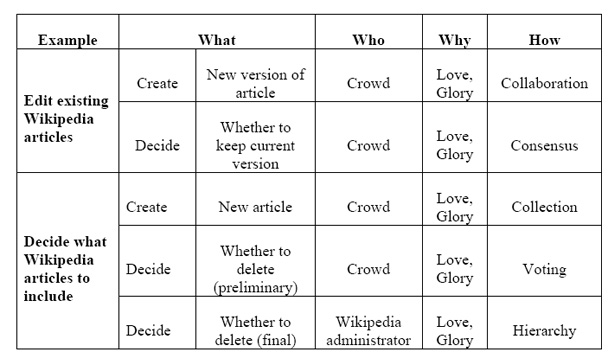Collective Intelligence
Contents
[hide]Collective intelligence is not a new phenomenon and has been in the focus of science and research for many years. A widely used approach traces back the roots of collective intelligences to evolutionary processes and refers to intelligence in groups.
DEFINITION
Decomposing collective intelligence etymologically, the term “collective” describes a group of individuals who are not required to have the same attitudes or view points. “Intelligence” refers to the ability to learn, to understand, and to adapt to an environment by using own knowledge. This enables people to deal with changing and difficult situations. Wechsler defines intelligence as composed or global ability of an individual to act purposeful, think reasonably, and to effectively deal with its environment.
Here are several widely accepted definitions:
- Collective intelligence is a form of universal, distributed intelligence, which arises from the collaboration and competition of many individuals. (Levy, 1997)
- Collective intelligence is the general ability of a group to perform a wide variety of tasks. (Woolley, 2010)
- The MIT Center for Collective Intelligence describes collective intelligence as very broadly groups of individuals doing things collectively that seems intelligent.
LEVELS OF ABSTRUCTION
Collective intelligence in humans appears is divided into three levels of abstraction: micro-level, macro-level and level of emergence.
MICRO-LEVEL
At the micro-level, collective intelligence is a combination of psychological, cognitive and behavioral elements.
- Humans as social animals. Viewing humans as social animals: immersion of self in a social network a typical human condition.
- Intelligence. The intelligence of individual human beings, often measured with the g-factor.
- Personal interaction capabilities. The factors affecting a person’s ability to interact with other human beings, such as emotional intelligence, social sensitivity and the general factor of personality.
- Trust. An actor’s expectation of the other party’s competence and goodwill.
- Motivation. The factors influencing the interest to participate in communities or to contribute to collective effort.
- Attention. The commitment of cognitive resources.
- Communities. Real and virtual communities, such as communities of practice and online social networks and brand communities.
MACRO-LEVEL
At the macro-level, collective intelligence becomes a statistical phenomenon, at least in the case of the „wisdom of crowds‟ effect. The term „wisdom of crowds‟ was coined by Surowiecki (2005) and it describes a phenomenon where, under certain conditions, large groups can achieve better results than any single individual in the group.
- Decision making. The process of making decisions, both individually and in groups.
- Wisdom of crowds. Under certain conditions, groups can be more intelligent than the smartest individuals in them; a collective estimate can be accurate, even if individual estimations are not (Surowiecki 2005)
- Aggregation. The combination of individual pieces of information to form a synthesis or collective estimation
- Bias. The tendency of individuals and groups to make systematical errors in decision making situations.
- Diversity. The differences in demographic, educational and cultural backgrounds and the ways that people represent and solve problems.
- Independence. The decision of an individual is not influenced by the decisions of other individuals.
LEVEL OF EMERGENCE
The level of emergence resides between the micro-level and the macro-level and deals with the question of how system behavior on the macro-level emerges from interactions of individuals at the micro-level.
- Complex adaptive systems. Systems that show adaptivity, self-organization and emergence.
- Self-organization. The emergence of order at the system level without central control, solely due to local interactions of the system’s components.
- Emergence. A rise of system level properties that are not present in its components; “the whole is more than the sum of its parts”.
- Swarmintelligence. The study of cognitively (relatively) simple entities, whose collective behavior is intelligent.
- Distributed memory. The shared, often external, dynamic memory system that performs parts of agents cognitive processes.
POTENTIALS AND AREAS OF APPLICATION
- Decision support. Can be divided into generating alternative solutions and evaluating them. For example, IdeaExchange from Salesforce.com allows customers to propose new product solutions and to evaluate existing proposals. http://sites.force.com/ideaexchange/
- Open Innovation. It refers to the opening of companies’ innovation processes by actively integrating the environment into these activities and thus extending its innovation capabilities for developing new products and services for wider areas of application. For example, LEGO advances its products with the help of its customers. The Lego Digital Designer provides a toolkit for users for designing individual product models. http://ldd.lego.com/
- Crowdsourcing. Based on the concept of outsourcing, the term crowdsourcing emerged, referring to the outsourcing of corporate activities to an independent mass of people (“crowd”). For example, Amazon’s Mechanical Turk allows companies or individuals to offer tasks to a mass of users on the Web that can be solved for a small fee. http://www.mturk.com/
- Social Collaboration. Value creation develops through (small) contributions of the collective. Most popular examples are Wikis with Wikipedia. http://wikipedia.org/
THE BUILDING BLOCKS OF COLLECTIVE INTELLIGENCE
WHO?
Who undertakes the activity?
There are two basic genes:
- Hierarchy. Someone in authority assigns a particular person or group of people to perform the task. The task may be assigned to personnel inside the firm or to people outside it.
- Crowd. Activities can be undertaken by anyone in a large group who chooses to do so, without being assigned by someone in a position of authority.
WHY?
Why do people take part in the activity? What motivates them to participate?
There are three basic Why genes which can cover the high level motivations that lead people to participate in collective intelligence systems:
- Money. The promise of financial gain is an important motivator for most actors in markets and traditional organizations. Sometimes people receive direct payments, like a salary, and sometimes they hope that participating in an activity will increase the likelihood of their earning future payments, as in cases where people perform a task to enhance their professional reputation or improve their skills.
- Love. It is an important motivator in many situations, even when there is no prospect of monetary gain. The Love gene can take several forms: people can be motivated by their intrinsic enjoyment of an activity, by the opportunities it provides to socialize with others, or because it makes them feel they are contributing to a cause larger than themselves.
- Glory or recognition. Many people are motivated by the desire to be recognized by peers for their contributions.
WHAT?
What is being done?
There are two basic genes:
- Create. The actors in the system generate something new—a piece of software code, a blog entry, a T-shirt design.
- Decide. The actors evaluate and select alternatives.
HOW?
How is it being done?
There are four primary How genes for Crowds: associated with the Create task are Collection and Collaboration, and with Decide task are Group Decision and Individual Decisions.
- Collection. The items contributed by members of the crowd are created independently of each other. For example, YouTube videos are created mostly independently of each other, and this makes YouTube a collection.
- Collaboration. Members of a Crowd work together to create something and important dependencies exist between their contributions. For example, even though there is extensive hyper-linking between them, articles in Wikipedia are meant to stand on their own as independent entities. This means Wikipedia as a whole is a Collection of articles. But the additions and editorial changes that different contributors make within a single Wikipedia article are strongly interdependent. So each individual Wikipedia article is a Collaboration, comprised of contributions submitted by a number of users.
- Group decision. Inputs from members of the crowd are assembled to generate a decision that holds for the group as a whole. Important variants of the Group Evaluation gene are Voting, Consensus, Averaging, and Prediction Markets.
- Individual decision. Members of a Crowd make decisions thatdo not need to be identical for all. For example, individual YouTube users decide for themselves which videos to watch. They may be influenced by recommendations or rankings from others, but they are not required to watch the same videos as others. Two important variations of the Individual Decisions gene are: Markets and Social Networks.
THE COLLECTIVE INTELLIGENCE GENOME FOR WIKIPEDIA
As described above editing individual Wikipedia articles is a form of Collaboration. Here is how the whole system based on CI genome works.
WHEN IT IS USEFUL
The Crowd gene is most useful in situations where the resources and skills needed to perform an activity are distributed widely or reside in places that are not known in advance. It must also be possible to divide the activity into pieces that can be performed satisfactorily by different members of the crowd.
The Collection gene is useful when it is possible to divide the overall activity into small pieces that can be done independently by different members of the crowd. If this condition is not in place, then the Collaboration gene is required.
The Contest gene is useful when all the conditions for a Collection hold and only one or a few good solutions are needed.
The Collaboration gene is useful when two conditions are met:
- Collection is impossible because there are no satisfactory ways of dividing the large activity into independent pieces.
- There are satisfactory ways of managing the dependencies between the individual pieces contributed by members of the crowd.
There is no main “step by step” formula to make the Collective Intelligence genome to work successfully for each idea. But answering the core for questions Who? Why? What? How? and its combination can lead to an effective way of development and growth.
REFERENCES
1. MIT Sloan School Working Paper 4732-09, 2/1/2009, Harnessing Crowds: Mapping the Genome of Collective Intelligence
2. James Surowiecki, The Wisdom of Crowds
3. Juho Salminen, Collective Intelligence in Humans
4. Thierry Buecheler, Jan Henrik Sieg, Rudolf M. Füchslin and Rolf Pfeifer, Crowdsourcing, Open Innovation and Collective Intelligence in the Scientific Method.
5. Bonabeau E (2009) Decisions 2.0: The power of collective intelligence. MIT Sloan Management Review 50(2)
6. Academy of management review, http://aom.org/amr/
7. BISE Journal, http://www.bise-journal.com/

